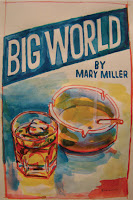Announcing Blackbird v10 n1 | Spring 2011
Blackbird: an online journal of literature and the arts published by Virginia Commonweath University, announces its new Spring 2011 issue featuring:
-A new translation and the original versions of Swedish poet Tomas Tranströmer’s 1996 book Sorrow Gondola, with an introductory essay by David Wojahn, a letter to Tranströmer by Jean Valentine, audio readings of three of the poems in Swedish, and video of Franz Liszt’s “Lugubre Gondola No. 2” that inspired the poem by the same title
-Audio of Victor Lodato, winner of the VCU Cabell First Novelist Award, Kathleen Graber, Jean Valentine, Kate Greenstreet, Jake Adam York,
Mathias Svalina, and Allison Titus
Mathias Svalina, and Allison Titus
--I praised Mathias Svalina's Destruction Myth and Allison Titus's Sum of Every Lost Ship in a previous issue of Blackbird; they're great evidence of the important poetry being published these days by Cleveland State University's Poetry Center--
-Poetry by Norman Dubie, Dave Smith, Jennifer Chang, Victoria Chang, Yu Shibuya,
Brittany Cavallaro, Jenny Johnson, Eve Jones, and more
--What a rockstar line-up!...watch in particular out for up & comers Brittany Cavallaro (whose poem I read for Linebreak) and Jenny Johnson (a friend from UVA days who has been studying with the fabulous Gabrielle Calvocoressi)--
Brittany Cavallaro, Jenny Johnson, Eve Jones, and more
--What a rockstar line-up!...watch in particular out for up & comers Brittany Cavallaro (whose poem I read for Linebreak) and Jenny Johnson (a friend from UVA days who has been studying with the fabulous Gabrielle Calvocoressi)--
-Fiction by Kelly Cherry, Steve Yarbrough, Victor Lodato, Adrian Dorris, Julie Hensley,
Darrin Doyle, Aurelie Sheehan, and Chris Leo
Darrin Doyle, Aurelie Sheehan, and Chris Leo
-Reviews of Joshua Poteat, Beckian Fritz Goldberg, Keith Montesano,
and Sandra Beasley*
and Sandra Beasley*
-In gallery, plays by Victor Lodato and Yasmine Rana, an audio essay by Jeff Porter, a video essay by Nick Twemlow and Robyn Schiff, and the U.S. Federal Civil Defense Administration’s 1951 “Duck and Cover”
*Me! This turns out to be a lovely review of I Was the Jukebox by Laura Van Prooyen, in which she says "Reading I Was the Jukebox cover to cover can hypnotize you."
Read the whole issue online by visiting http://www.blackbird.vcu.edu

















